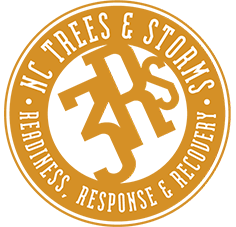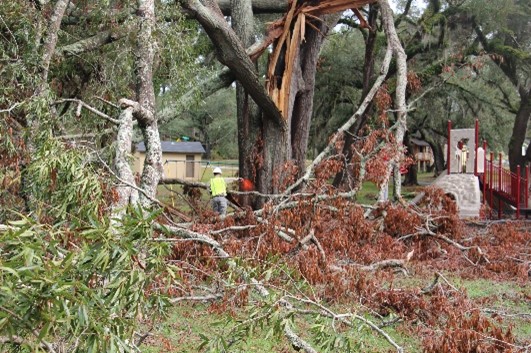
NC Trees and Storms: Readiness, Response, Recovery
 Storms damage trees. Tree-damaging storm events occur with regular frequency across North Carolina. Thunderstorms frequently leave tree damage in their wake. Less frequent tornados, ice storms and hurricanes cause serious and widespread tree damage. Downed tree branches and trees can injure people, cause property damage, disrupt our daily lives and result in significant costs for cleanup and to repair the damage. We need to work to minimize these risks. Trees enhance our health, provide ecosystem services and our quality of living. We should work to conserve trees to realize these benefits.
Are you Ready to Respond to and Recover from a tree-damaging storm event? Did you know some of this tree damage can be prevented through proactive tree management? Being prepared will help ensure your response to a storm event is effective and efficient. Employ the NC Trees and Storms 3Rs process.
Storms damage trees. Tree-damaging storm events occur with regular frequency across North Carolina. Thunderstorms frequently leave tree damage in their wake. Less frequent tornados, ice storms and hurricanes cause serious and widespread tree damage. Downed tree branches and trees can injure people, cause property damage, disrupt our daily lives and result in significant costs for cleanup and to repair the damage. We need to work to minimize these risks. Trees enhance our health, provide ecosystem services and our quality of living. We should work to conserve trees to realize these benefits.
Are you Ready to Respond to and Recover from a tree-damaging storm event? Did you know some of this tree damage can be prevented through proactive tree management? Being prepared will help ensure your response to a storm event is effective and efficient. Employ the NC Trees and Storms 3Rs process.Readiness

Utilizing the emergency management Incident Command System (ICS) structure learn and acquire the leadership, planning, administrative and operational tasks and resources that will be required. Develop a plan to reduce storm tree-damage and efficiently and effectively respond to a tree-damaging storm event of any scale.
Response

Recovery
 The response phase is over, and hazardous tree remediation work is complete. The work is not finished. You are left with trees that have varying degrees of damage, and these trees can range in number from many to few. Your storm damage inventory has a list of trees that should be removed and pruned. Cull the severely damaged trees and prune the remaining damaged trees to reduce the risks of higher losses in the future. Your community trees provide services that enhance the quality of living in your community. Invest in maintaining your community trees as you do with other elements of your community’s infrastructure and plant trees for the future to fully realize those benefits. Completing the work now will come at a cost, but the cost will be greater in the future if you do not act.
The response phase is over, and hazardous tree remediation work is complete. The work is not finished. You are left with trees that have varying degrees of damage, and these trees can range in number from many to few. Your storm damage inventory has a list of trees that should be removed and pruned. Cull the severely damaged trees and prune the remaining damaged trees to reduce the risks of higher losses in the future. Your community trees provide services that enhance the quality of living in your community. Invest in maintaining your community trees as you do with other elements of your community’s infrastructure and plant trees for the future to fully realize those benefits. Completing the work now will come at a cost, but the cost will be greater in the future if you do not act.
Urban Forest Strike Team
 Your community has suffered a tree-damaging storm event. Storm damaged trees located on your community’s rights-of-way or properties have sustained varying degrees of damage and will need to be pruned or removed. If a Federal Disaster has been declared the cost to remove storm damaged trees is eligible for disaster assistance. An Urban Forest Strike Team (UFST) of qualified foresters will complete an assessment your public trees for management needs and FEMA reimbursement purposes in cases of a declared Federal Disaster. The objectives are to provide professional storm damage tree assessment services to communities to assist with storm response and recovery efforts as well as retain as much viable, low risk tree canopy as possible following a storm event.
Your community has suffered a tree-damaging storm event. Storm damaged trees located on your community’s rights-of-way or properties have sustained varying degrees of damage and will need to be pruned or removed. If a Federal Disaster has been declared the cost to remove storm damaged trees is eligible for disaster assistance. An Urban Forest Strike Team (UFST) of qualified foresters will complete an assessment your public trees for management needs and FEMA reimbursement purposes in cases of a declared Federal Disaster. The objectives are to provide professional storm damage tree assessment services to communities to assist with storm response and recovery efforts as well as retain as much viable, low risk tree canopy as possible following a storm event.